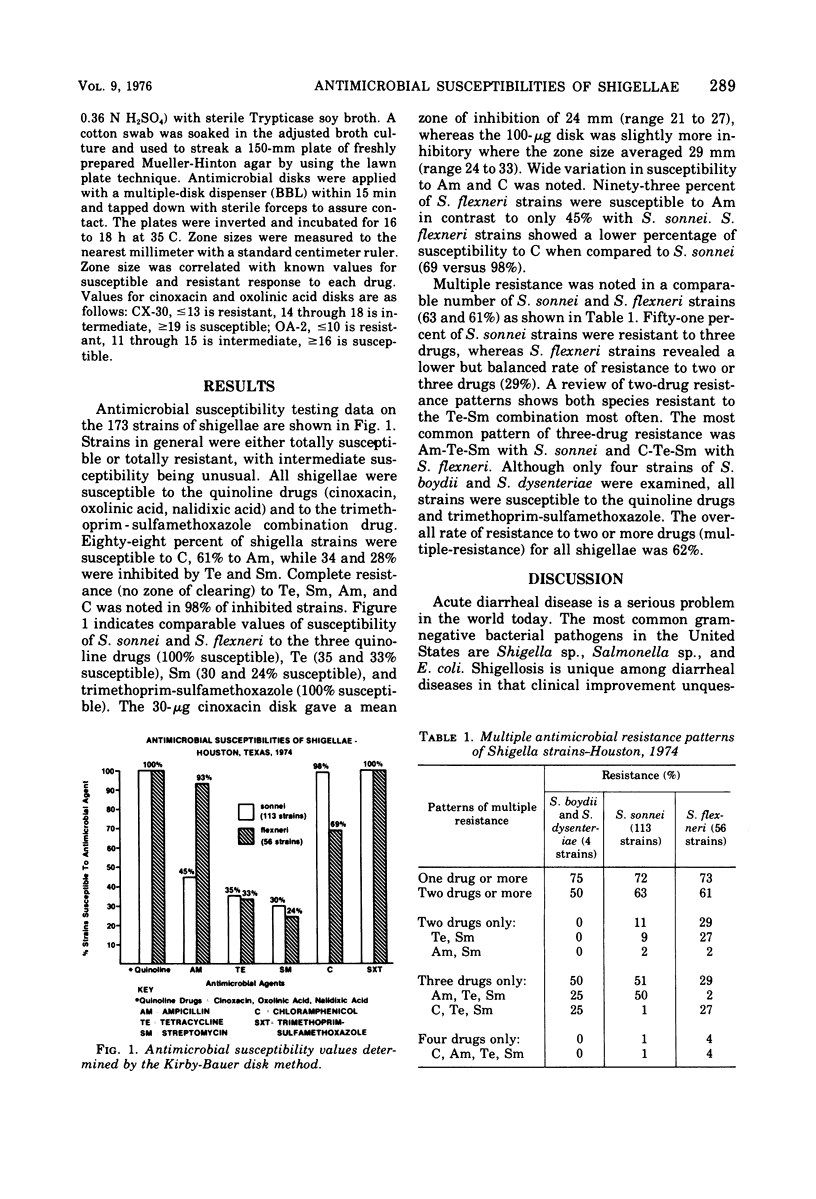Abstract
One hundred seventy-three strains of shigellae (113 Shigella sonnei, 56 S. flexneri, and four others) isolated in Houston during 1974 were tested for susceptibility to commonly used and newer antimicrobial agents. Forty-five percent of S. sonnei strains were susceptible to ampicillin, whereas 93% of S. flexneri strains were susceptible to that agent. S. sonnei and S. flexneri strains were equally susceptible to tetracycline (35 and 33%, respectively). All 173 strains were uniformly susceptible to quinoline drugs (cinoxacin, oxolinic acid, and nalidixic acid) and to trimethoprim-sulfamethoxazole. This study supports recent suggestions that the initial therapy of bacillary dysentery no longer should be ampicillin or tetracycline. It remains for field testing to determine whether quinoline agents or trimethoprim-sulfamethoxazole will be the treatment of choice.
Full text
PDF



Selected References
These references are in PubMed. This may not be the complete list of references from this article.
- Atlas E., Clark H., Silverblatt F., Turck M. Nalidixic acid and oxolinic acid in the treatment of chronic bacteriuria. Ann Intern Med. 1969 Apr;70(4):713–721. doi: 10.7326/0003-4819-70-4-713. [DOI] [PubMed] [Google Scholar]
- DuPont H. L., Hornick R. B. Adverse effect of lomotil therapy in shigellosis. JAMA. 1973 Dec 24;226(13):1525–1528. [PubMed] [Google Scholar]
- Farrar W. E., Jr, Eidson M. Antibiotic resistance in Shigella mediated by R factors. J Infect Dis. 1971 May;123(5):477–484. doi: 10.1093/infdis/123.5.477. [DOI] [PubMed] [Google Scholar]
- Franzén C., Lidin-Janson G., Nygren B. Trimethoprim-sulphamethoxazole in enteric infections. Scand J Infect Dis. 1972;4(3):231–240. doi: 10.3109/inf.1972.4.issue-3.10. [DOI] [PubMed] [Google Scholar]
- Gordon R. C., Thompson T. R., Carlson W., Dyke J. W., Stevens L. I. Antimicrobial resistance of Shigellae isolated in Michigan. JAMA. 1975 Mar 17;231(11):1159–1161. [PubMed] [Google Scholar]
- Haltalin K. C., Nelson J. D., Kusmiesz H. T. Comparative efficacy of nalidixic acid and ampicillin for severe shigellosis. Arch Dis Child. 1973 Apr;48(4):305–312. doi: 10.1136/adc.48.4.305. [DOI] [PMC free article] [PubMed] [Google Scholar]
- Haltalin K. C., Nelson J. D., Ring R., 3rd, Sladoje M., Hinton L. V. Double-blind treatment study of shigellosis comparing ampicillin, sulfadiazine, and placebo. J Pediatr. 1967 Jun;70(6):970–981. doi: 10.1016/s0022-3476(67)80275-0. [DOI] [PubMed] [Google Scholar]
- Lexomboon U., Mansuwan P., Duangmani C., Benjadol P., M'cMinn M. T. Clinical evaluation of co-trimoxazole and furazolidone in treatment of shigellosis in children. Br Med J. 1972 Jul 1;3(5817):23–26. doi: 10.1136/bmj.3.5817.23. [DOI] [PMC free article] [PubMed] [Google Scholar]
- Michel J., Luboshitzky R., Sacks T. Bactericidal effect of combinations of nalidixic acid and various antibiotics on Enterobacteriaceae. Antimicrob Agents Chemother. 1973 Sep;4(3):201–204. doi: 10.1128/aac.4.3.201. [DOI] [PMC free article] [PubMed] [Google Scholar]
- Münnich D., Lakatos M. Treatment of shigellosis with poteseptyl (trimethoprim+superseptyl). Chemotherapy. 1974;20(2):113–119. doi: 10.1159/000221799. [DOI] [PubMed] [Google Scholar]
- Ross S., Controni G., Khan W. Resistance of shigellae to ampicillin and other antibiotics. Its clinical and epidemiological implications. JAMA. 1972 Jul 3;221(1):45–47. [PubMed] [Google Scholar]
- Rudoy R. C., Nelson J. D., Haltalin K. C. In vitro susceptibility of Shigella strains to trimethoprim and sulfamethoxazole. Antimicrob Agents Chemother. 1974 May;5(5):439–443. doi: 10.1128/aac.5.5.439. [DOI] [PMC free article] [PubMed] [Google Scholar]


